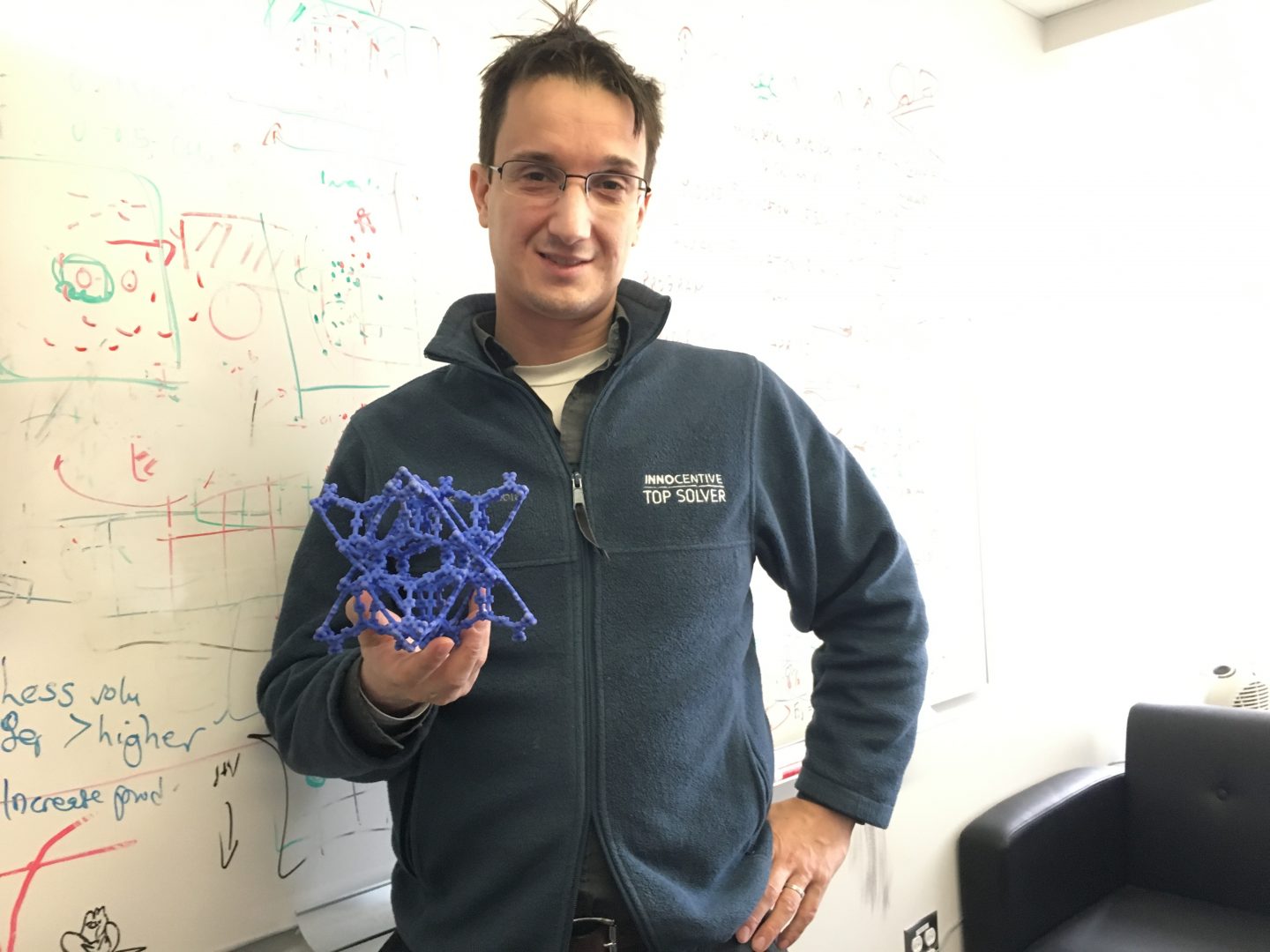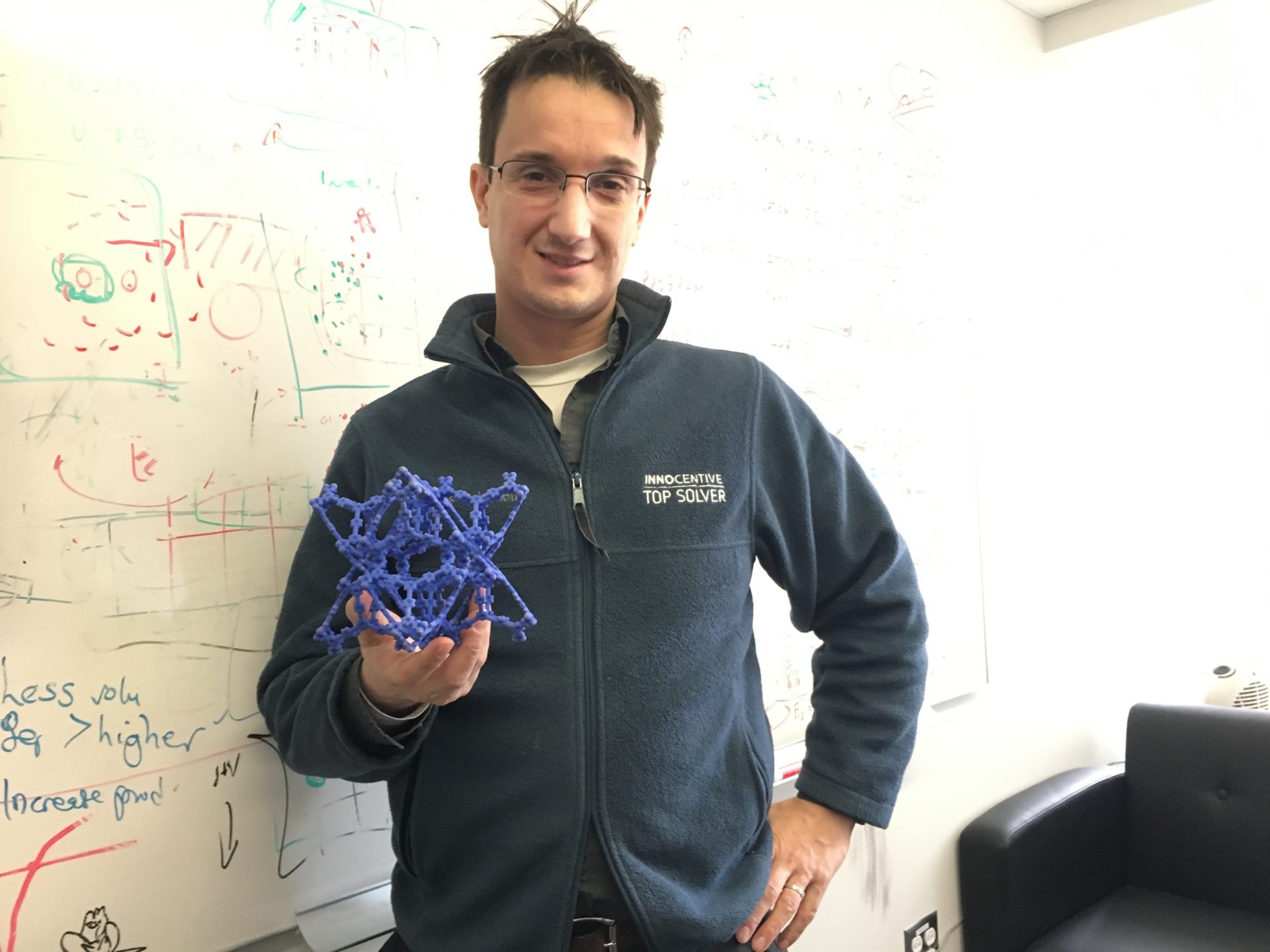
Chris Wilmer, assistant professor of chemical engineering at the University of Pittsburgh, holds a model of a metal organic framework.
Amy Sisk / StateImpact Pennsylvania


Chris Wilmer, assistant professor of chemical engineering at the University of Pittsburgh, holds a model of a metal organic framework.
Amy Sisk / StateImpact Pennsylvania

Amy Sisk / StateImpact Pennsylvania
Chris Wilmer, assistant professor of chemical engineering at the University of Pittsburgh, holds a model of a metal organic framework.

Amy Sisk / StateImpact Pennsylvania
Chris Wilmer, assistant professor of chemical engineering at the University of Pittsburgh, holds a model of a metal organic framework.
Pittsburgh researchers are working on potentially cheaper ways to capture carbon dioxide from coal-fired power plants.
So-called “clean coal” technology is expensive, but some experts say it’s crucial to address climate change.
Researchers from the University of Pittsburgh and a nearby Department of Energy lab collaborated to model membranes that could be used to filter exhaust gas from power plants.
Chris Wilmer, an assistant professor of chemical engineering at Pitt, said those membranes are a combination of polymers — a plastic film — and metal organic frameworks. Those MOFs, as they’re called, are metals like copper and zinc bound to organic molecules made up of carbon and other atoms, such as hydrogen.
“A bath sponge is a good way of visualizing it,” Wilmer said. “The way a bath sponge soaks up water, these sponge-like materials soak up gases.”
Wilmer used a computer to model millions of potential membranes. He said exhaust gas from the power plant would get sent through the membranes alongside a power plant.
“If they work well, what you would end up with coming out on one side is just nitrogen gas, which is fine to emit into the air, and on one of the other exhausts you’d have pure CO2,” he said.
The way power plants currently operate, the exhaust gas gets released into the air, and the carbon dioxide in it contributes to global warming by trapping heat within the atmosphere. Using membranes, the carbon dioxide could be captured and piped somewhere for storage, likely underground.
Wilmer worked with researchers from the National Energy Technology Laboratory, which has a facility south of Pittsburgh.
“One thing that they’re really good at doing is predicting how much a carbon capture process would cost,” he said.
They estimated that capturing carbon using those membranes could bring costs down to $50 per ton. He said other technology costing $80-$100 per ton uses solvents to bind to carbon dioxide. Those solvents then need to be heated to separate from the gas. That process is more energy-intensive, which adds to the price.
A lot of carbon capture research takes place in Pennsylvania, but the technology has never been used here. Wilmer said some carbon capture pilot projects exist elsewhere, and a test project would be the next step for the membranes.
“Climate change is certainly the primary motivation for this work, but it could be that the best solution is not to install carbon capture technology,” Wilmer said. “The best solution could be turning off the coal power plant and installing solar panels.”
StateImpact Pennsylvania is a collaboration among WITF, WHYY, and the Allegheny Front. Reporters Reid Frazier, Rachel McDevitt and Susan Phillips cover the commonwealth’s energy economy. Read their reports on this site, and hear them on public radio stations across Pennsylvania.
(listed by story count)
StateImpact Pennsylvania is a collaboration among WITF, WHYY, and the Allegheny Front. Reporters Reid Frazier, Rachel McDevitt and Susan Phillips cover the commonwealth’s energy economy. Read their reports on this site, and hear them on public radio stations across Pennsylvania.
Climate Solutions, a collaboration of news organizations, educational institutions and a theater company, uses engagement, education and storytelling to help central Pennsylvanians toward climate change literacy, resilience and adaptation. Our work will amplify how people are finding solutions to the challenges presented by a warming world.